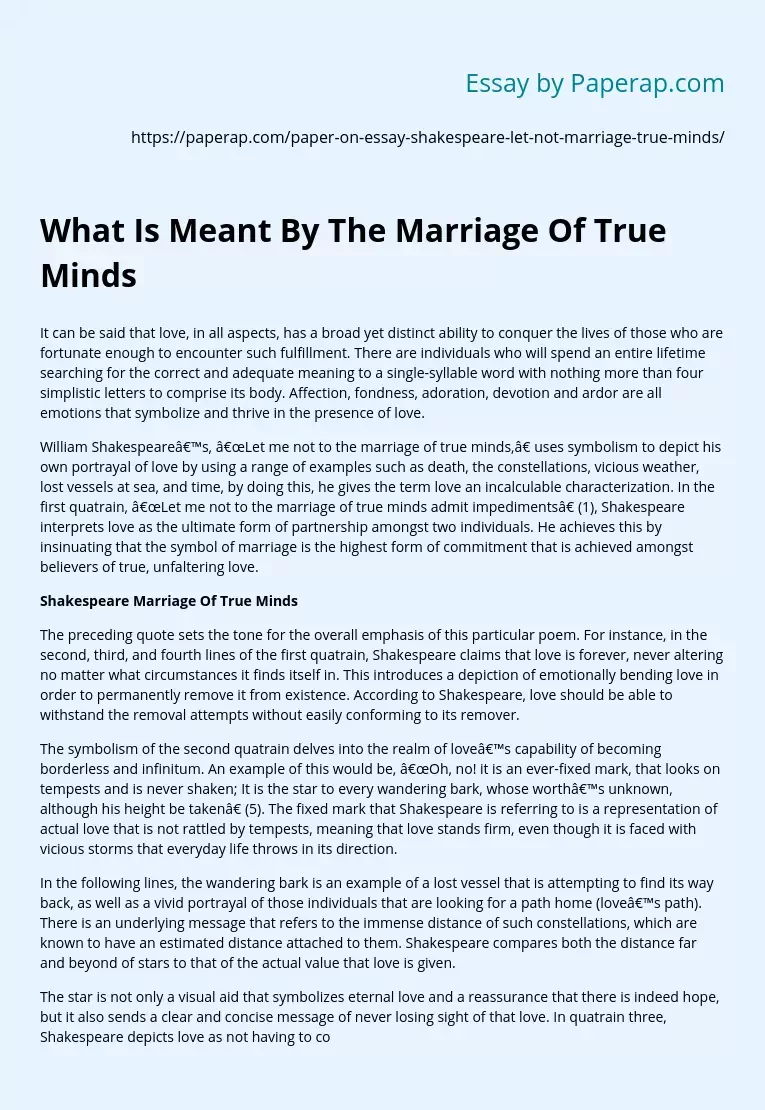It can be said that love, in all aspects, has a broad yet distinct ability to conquer the lives of those who are fortunate enough to encounter such fulfillment. There are individuals who will spend an entire lifetime searching for the correct and adequate meaning to a single-syllable word with nothing more than four simplistic letters to comprise its body. Affection, fondness, adoration, devotion and ardor are all emotions that symbolize and thrive in the presence of love.
William Shakespeare’s, “Let me not to the marriage of true minds,” uses symbolism to depict his own portrayal of love by using a range of examples such as death, the constellations, vicious weather, lost vessels at sea, and time, by doing this, he gives the term love an incalculable characterization.
In the first quatrain, “Let me not to the marriage of true minds admit impediments” (1), Shakespeare interprets love as the ultimate form of partnership amongst two individuals. He achieves this by insinuating that the symbol of marriage is the highest form of commitment that is achieved amongst believers of true, unfaltering love.
Shakespeare Marriage Of True Minds
The preceding quote sets the tone for the overall emphasis of this particular poem. For instance, in the second, third, and fourth lines of the first quatrain, Shakespeare claims that love is forever, never altering no matter what circumstances it finds itself in. This introduces a depiction of emotionally bending love in order to permanently remove it from existence. According to Shakespeare, love should be able to withstand the removal attempts without easily conforming to its remover.
The symbolism of the second quatrain delves into the realm of love’s capability of becoming borderless and infinitum. An example of this would be, “Oh, no! it is an ever-fixed mark, that looks on tempests and is never shaken; It is the star to every wandering bark, whose worth’s unknown, although his height be taken” (5). The fixed mark that Shakespeare is referring to is a representation of actual love that is not rattled by tempests, meaning that love stands firm, even though it is faced with vicious storms that everyday life throws in its direction.
In the following lines, the wandering bark is an example of a lost vessel that is attempting to find its way back, as well as a vivid portrayal of those individuals that are looking for a path home (love’s path). There is an underlying message that refers to the immense distance of such constellations, which are known to have an estimated distance attached to them. Shakespeare compares both the distance far and beyond of stars to that of the actual value that love is given.
The star is not only a visual aid that symbolizes eternal love and a reassurance that there is indeed hope, but it also sends a clear and concise message of never losing sight of that love. In quatrain three, Shakespeare depicts love as not having to conform to time here on Earth. In his view, love surpasses the time allotted to a given individual. He makes this obvious when he describes physical aspects such as the rosy lips and cheeks in a way that is reminiscent of wedding vows.
Beauty comes and goes with age, but if love is indeed true, then love perseveres through the trials and tribulations associated with the unexpected. At the end of the poem in quatrain three, Shakespeare proclaims, “If this be error and upon me proved, I never writ, nor man ever loved” (13). After everything is said and done, he acknowledges the fact that if he is proved wrong about what love truly means, then he repudiates everything that he has written thus far. Symbols have a multitude of ways of defining a story, an article, or in this case, a poem.
The function of symbolism in this particular poem serves as a clue box that correlates the many aspects of love to that of nature and time. Shakespeare has a rather keen way of giving a particular object a different meaning, not because it signifies different things, but because one object can be seen in distinct ways by an array of different people analyzing that specific poem. When it is all said and done, this poem is a reflection of what true love epitomizes and the lengths to which Shakespeare goes in order to illustrate that imperfect, yet immeasurable term called, love.
What Is Meant By The Marriage Of True Minds. (2019, Dec 05). Retrieved from https://paperap.com/paper-on-essay-shakespeare-let-not-marriage-true-minds/

